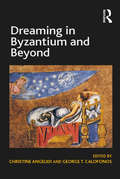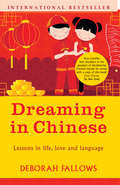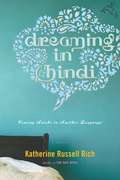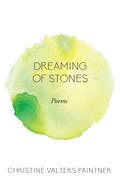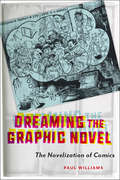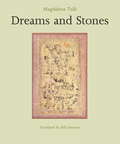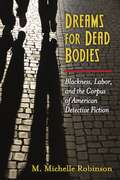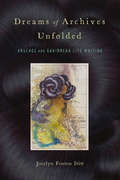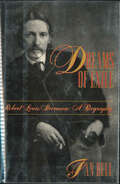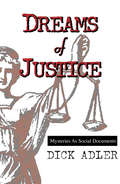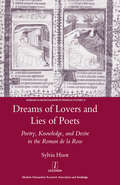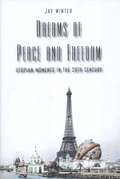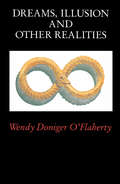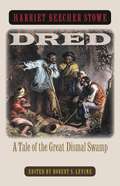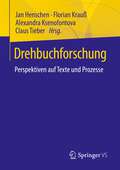- Table View
- List View
Dreaming by the Book
by Elaine ScarryA pathbreaking work about the way literature teaches us to use our imagination.We often attribute to our imaginative life powers that go beyond ordinary perception or sensation. In Dreaming by the Book, the noted scholar Elaine Scarry explores the apparently miraculous but in fact understandable processes by which poets and writers confer those powers on us: how they teach us the work of imaginative creation.Writers from Homer to Heaney, Scarry argues, instruct us in the art of mental composition even as their poems progress: just as painters understand paint, composers musical sounds, and sculptors stone or metal, verbal artists understand and deploy the only material in which their creations will get made - the backlit tissue of the human imagination. In her brilliant synthesis of cognitive psychology, literary criticism, and philosophy, she explores the five principal formal practices by which writers bring things to life for their readers; she calls them radiant ignition, rarity, dyadic addition and subtraction, stretching, and floral supposition. The transforming power of these mental practices can be seen in their appearance in great literature, of course, but also in applying them to - and watching how they revise - our own daydreams.Dreaming by the Book is not only an utterly original work of literary analysis but a sequence of on-the-spot mental experiments.
Dreaming in Byzantium and Beyond
by George T. CalofonosAlthough the actual dreaming experience of the Byzantines lies beyond our reach, the remarkable number of dream narratives in the surviving sources of the period attests to the cardinal function of dreams as vehicles of meaning, and thus affords modern scholars access to the wider cultural fabric of symbolic representations of the Byzantine world. Whether recounting real or invented dreams, the narratives serve various purposes, such as political and religious agendas, personal aspirations or simply an author’s display of literary skill. It is only in recent years that Byzantine dreaming has attracted scholarly attention, and important publications have suggested the way in which Byzantines reshaped ancient interpretative models and applied new perceptions to the functions of dreams. This book - the first collection of studies on Byzantine dreams to be published - aims to demonstrate further the importance of closely examining dreams in Byzantium in their wider historical and cultural, as well as narrative, context. Linked by this common thread, the essays offer insights into the function of dreams in hagiography, historiography, rhetoric, epistolography, and romance. They explore gender and erotic aspects of dreams; they examine cross-cultural facets of dreaming, provide new readings, and contextualize specific cases; they also look at the Greco-Roman background and Islamic influences of Byzantine dreams and their Christianization. The volume provides a broad variety of perspectives, including those of psychoanalysis and anthropology.
Dreaming in Chinese: ... and Discovering What Makes a Billion People Tick
by Deborah FallowsThis is a book to appeal to anyone with an interest in China, be they first time tourists, seasoned business people, or even the idly curious. Accessible, revelatory and entertaining, it will help you discover this extraordinary nation for yourself.
Dreaming in Hindi: Coming Awake in Another Language
by Katherine Russell RichAn eye-opening and courageous memoir that explores what learning a new language can teach us about distant worlds and, ultimately, ourselves. After miraculously surviving a serious illness, Katherine Rich found herself at an impasse in her career as a magazine editor. She spontaneously accepted a freelance writing assignment to go to India, where she found herself thunderstruck by the place and the language, and before she knew it she was on her way to Udaipur, a city in the northwestern state of Rajasthan, in order to learn Hindi. Rich documents her experiences--ranging from the bizarre to the frightening to the unexpectedly exhilarating--using Hindi as the lens through which she is given a new perspective not only on India, but on the radical way the country and the language itself were changing her. Fascinated by the process, she went on to interview linguistics experts around the world, reporting back from the frontlines of the science wars on what happens in the brain when we learn a new language. She brings both of these experiences together seamlessly in Dreaming in Hindi, a remarkably unique and thoughtful account of self-discovery.
Dreaming in Hindi: Coming Awake in Another Language
by Katherine Russell RichAn eye-opening and courageous memoir that explores what learning a new language can teach us about distant worlds and, ultimately, ourselves. After miraculously surviving a serious illness, Katherine Rich found herself at an impasse in her career as a magazine editor. She spontaneously accepted a freelance writing assignment to go to India, where she found herself thunderstruck by the place and the language, and before she knew it she was on her way to Udaipur, a city in the northwestern state of Rajasthan, in order to learn Hindi. Rich documents her experiences--ranging from the bizarre to the frightening to the unexpectedly exhilarating--using Hindi as the lens through which she is given a new perspective not only on India, but on the radical way the country and the language itself were changing her. Fascinated by the process, she went on to interview linguistics experts around the world, reporting back from the frontlines of the science wars on what happens in the brain when we learn a new language. She brings both of these experiences together seamlessly in Dreaming in Hindi, a remarkably unique and thoughtful account of self-discovery.
Dreaming of Cockaigne: Medieval Fantasies of the Perfect Life
by Herman Pleij Diane WebbImagine a dreamland where roasted pigs wander about with knives in their backs to make carving easy, where grilled geese fly directly into one's mouth, where cooked fish jump out of the water and land at one's feet. The weather is always mild, the wine flows freely, sex is readily available, and all people enjoy eternal youth. Such is Cockaigne. Portrayed in legend, oral history, and art, this imaginary land became the most pervasive collective dream of medieval times-an earthly paradise that served to counter the suffering and frustration of daily existence and to allay anxieties about an increasingly elusive heavenly paradise. Illustrated with extraordinary artwork from the Middle Ages, Herman Pleij's Dreaming of Cockaigne is a spirited account of a lost paradise and the world that brought it to life. Pleij takes three important texts as his starting points for an inspired of the panorama of ideas, dreams, popular religion, and literary and artistic creation present in the late Middle Ages. What emerges is a well-defined picture of the era, furnished with a wealth of detail from all of Europe, as well as Asia and America. Pleij draws upon his thorough knowledge of medieval European literature, art, history, and folklore to describe the fantasies that fed the tales of Cockaigne and their connections to the central obsessions of medieval life.
Dreaming of Cockaigne: Medieval Fantasies of the Perfect Life
by Herman PleijImagine a dreamland where roasted pigs wander about with knives in their backs to make carving easy, where grilled geese fly directly into one's mouth, where cooked fish jump out of the water and land at one's feet. The weather is always mild, the wine flows freely, sex is readily available, and all people enjoy eternal youth.Such is Cockaigne. Portrayed in legend, oral history, and art, this imaginary land became the most pervasive collective dream of medieval times-an earthly paradise that served to counter the suffering and frustration of daily existence and to allay anxieties about an increasingly elusive heavenly paradise.Illustrated with extraordinary artwork from the Middle Ages, Herman Pleij's Dreaming of Cockaigne is a spirited account of this lost paradise and the world that brought it to life. Pleij takes three important texts as his starting points for an inspired of the panorama of ideas, dreams, popular religion, and literary and artistic creation present in the late Middle Ages. What emerges is a well-defined picture of the era, furnished with a wealth of detail from all of Europe, as well as Asia and America.Pleij draws upon his thorough knowledge of medieval European literature, art, history, and folklore to describe the fantasies that fed the tales of Cockaigne and their connections to the central obsessions of medieval life.
Dreaming of Stones: Poems (Paraclete Poetry)
by Christine Valters PaintnerThe poems in Dreaming of Stones are about what endures: hope and desire, changing seasons, wild places, love, and the wisdom of mystics. Inspired by the poet's time living in Ireland these readings invite you into deeper ways of seeing the world. They have an incantational quality. Drawing on her commitment as a Benedictine oblate, the poems arise out of a practice of sitting in silence and lectio divina, in which life becomes the holy text. No stranger to poetry, Paintner's bestselling spirituality titles have often included poems. In this first exclusively poetic collection, she writes with a contemplative heart about kinship with nature, ancestral connections, intimacy, the landscape, the unfolding nature of time, and Christian mystics. It can be read for reflection to spark the heart and to offer solace and inspiration in difficult times. Breath This breathing in is a miracle, this breathing out, release, this breathing in a welcome to the unseen gifts which sustain me each moment, this breathing out a sweet sigh, a bow to my mortality, this breathing in a holy yes to life, this breathing out a sacred no to all that causes me to clench and grasp, this breathing in is a revelation, this breathing out, freedom.
Dreaming the Graphic Novel: The Novelization of Comics
by Paul WilliamsThe term “graphic novel” was first coined in 1964, but it wouldn’t be broadly used until the 1980s, when graphic novels such as Watchmen and Maus achieved commercial success and critical acclaim. What happened in the intervening years, after the graphic novel was conceptualized yet before it was widely recognized? Dreaming the Graphic Novel examines how notions of the graphic novel began to coalesce in the 1970s, a time of great change for American comics, with declining sales of mainstream periodicals, the arrival of specialty comics stores, and (at least initially) a thriving underground comix scene. Surveying the eclectic array of long comics narratives that emerged from this fertile period, Paul Williams investigates many texts that have fallen out of graphic novel history. As he demonstrates, the question of what makes a text a ‘graphic novel’ was the subject of fierce debate among fans, creators, and publishers, inspiring arguments about the literariness of comics that are still taking place among scholars today. Unearthing a treasure trove of fanzines, adverts, and unpublished letters, Dreaming the Graphic Novel gives readers an exciting inside look at a pivotal moment in the art form’s development.
Dreams Must Explain Themselves: The Selected Non-Fiction of Ursula K. Le Guin
by Ursula K. Le Guin'By turns sharp, funny and insightful, high-minded but never mean-spirited, the book embodies its author's lifelong quest for freedom: freedom as a woman, freedom to write what she pleased, freedom to like what she liked. Genre fiction - and literature in general - has lost not just one of its brightest exponents but one of its bolshiest champions.' FINANCIAL TIMES'Excellent' CHOICE'Le Guin is one of the singular speculative voices of our future, thanks to her knack for anticipating issues of seminal importance to society' TLSUrsula K. Le Guin has won or been nominated for over 200 awards for her fiction, including the Hugo, Nebula, World Fantasy and SFWA Grand Master Awards. She is the acclaimed author of the Earthsea sequence and The Left Hand of Darkness - which alone would qualify her for literary immortality - as well as a remarkable body of short fiction, including the powerful, Hugo-winning 'The Ones Who Walk Away from Omelas' and the masterpiece of anthropological and environmental SF 'The Word for World is Forest' - winner of the Hugo Award for best novella. But Ursula Le Guin's talents do not stop at fiction. Over the course of her extraordinary career, she has penned numerous essays around themes important to her: anthropology, environmentalism, feminism, social justice and literary criticism to name a few. She has responded in detail to criticism of her own work and even reassessed that work in the context of such critiques. This selection of the best of Le Guin's non-fiction shows an agile mind, an unparalleled imagination and a ferocious passion to argue against injustice. In 2014 Ursula Le Guin was awarded the National Book Foundation's Medal for Distinguished Contribution to American Letters, and her widely praised acceptance speech is one of the highlights of this volume, which shows that one of modern literature's most original voices is also one of its purest consciences.
Dreams and Experience in Classical Antiquity
by William V. HarrisFrom the Iliad to Aristophanes, from the gospel of Matthew to Augustine, Greek and Latin texts are constellated with descriptive images of dreams. Some are formulaic, others intensely vivid. The best ancient minds—Plato, Aristotle, the physician Galen, and others—struggled to understand the meaning of dreams. With Dreams and Experience in Classical Antiquity the renowned ancient historian William Harris turns his attention to oneiric matters. This cultural history of dreams in antiquity draws on both contemporary post-Freudian science and careful critiques of the ancient texts. Harris traces the history of characteristic forms of dream-description and relates them both to the ancient experience of dreaming and to literary and religious imperatives. He analyzes the nuances of Greek and Roman belief in the truth-telling potential of dreams, and in a final chapter offers an assessment of ancient attempts to understand dreams naturalistically. How did dreaming culture evolve from Homer’s time to late antiquity? What did these dreams signify? And how do we read and understand ancient dreams through modern eyes? Harris takes an elusive subject and writes about it with rigor and precision, reminding us of specificities, contexts, and changing attitudes through history.
Dreams and Stones
by Bill Johnston Magdalena TulliDreams and Stones is a small masterpiece, one of the most extraordinary works of literature to come out of Central and Eastern Europe since the fall of communism. In sculpted, poetic prose reminiscent of Bruno Schulz, it tells the story of the emergence of a great city. In Tulli's hands myth, metaphor, history, and narrative are combined to magical effect. Dreams and Stones is about the growth of a city, and also about all cities; at the same time it is not about cities at all, but about how worlds are created, trans- formed, and lost through words alone. A stunning debut by one of Europe's finest new writers.
Dreams for Dead Bodies
by Miriam Michelle RobinsonDreams for Dead Bodies: Blackness, Labor, and the Corpus of American Detective Fiction offers new arguments about the origins of detective fiction in the United States, tracing the lineage of the genre back to unexpected texts and uncovering how authors such as Edgar Allan Poe, Mark Twain, Pauline Hopkins, and Rudolph Fisher made use of the genre's puzzle-elements to explore the shifting dynamics of race and labor in America. The author constructs an interracial genealogy of detective fiction to create a nuanced picture of the ways that black and white authors appropriated and cultivated literary conventions that coalesced in a recognizable genre at the turn of the twentieth century. These authors tinkered with detective fiction's puzzle-elements to address a variety of historical contexts, including the exigencies of chattel slavery, the erosion of working-class solidarities by racial and ethnic competition, and accelerated mass production.Dreams for Dead Bodies demonstrates that nineteenth- and early twentieth-century American literature was broadly engaged with detective fiction, and that authors rehearsed and refined its formal elements in literary works typically relegated to the margins of the genre. By looking at these margins, the book argues, we can better understand the origins and cultural functions of American detective fiction.
Dreams in Chinese Fiction: Spiritism, Aestheticism, and Nationalism (Routledge Focus on Literature)
by Johannes D. KaminskiThis book considers the contemporary political formula of the “Chinese Dream” in the light of the treatment of dreams in Chinese literary history since antiquity. Sinic literary and philosophical texts document an extensive spectrum of dream possibilities: starting with Zhuangzi’s eminent butterfly dream, an early example of the inversion of the dreamer’s reality, through to confusing visions of the spiritual realm. In classical dramas, novels, and ghost stories, dreams see the earthly realm enter into conflict with higher realms of existence. They indulge the dreamer’s quest for sensual pleasures, but then spiritual beings relentlessly harvest the dreamers’ life energy. Dreams promise spiritual enlightenment – only to abandon the dreamer in a state of utter confusion. In the early twentieth century, traditional dream knowledge is abandoned in favour or Freudian episodes of sexual repression. In this context, the collective national dream emerges as an unexpected vehicle of the pained individual’s hope for national rejuvenation.
Dreams of Archives Unfolded: Absence and Caribbean Life Writing (Critical Caribbean Studies)
by Jocelyn Fenton StittThe first book on pan-Caribbean life writing, Dreams of Archives Unfolded reveals the innovative formal practices used to write about historical absences within contemporary personal narratives. Although the premier genres of writing postcoloniality in the Caribbean have been understood to be fiction and poetry, established figures such as Erna Brodber, Maryse Condé, Lorna Goodison, Edwidge Danticat, Saidiya Hartmann, Ruth Behar, and Dionne Brand and emerging writers such as Yvonne Shorter Brown, and Gaiutra Bahadur use life writing to question the relationship between the past and the present. Stitt theorizes that the remarkable flowering of life writing by Caribbean women since 2000 is not an imitation of the “memoir boom” in North America and Europe; instead, it marks a different use of the genre born out of encountering gendered absences in archives and ancestral memory that cannot be filled with more research. Dreams of Archives makes a significant contribution to studies of Caribbean literature by demonstrating that women’s autobiographical narratives published in the past twenty years are feminist epistemological projects that rework Caribbean studies’ longstanding commitment to creating counter-archives.
Dreams of Difference: The Japan Romantic School and the Crisis of Modernity
by Kevin Michael DoakFrom 1935 to 1945, the Japan Romantic School (Nihon Romanha), a group of major intellectuals and literary figures, explored issues concerning politics, literature, and nationalism in ways that still influence cultural discourse in Japan today. Kevin Doak's timely study is a broad critique of modernity in early twentieth-century Japan. He uses close readings and translations of texts and poems to suggest that the school's interest in romanticism stemmed from its attempt to surmount the "cultural crisis" of lost traditions. This attempt to overcome modernity eventually reduced the movement's earlier critical impulses to expressions of nationalist longing.
Dreams of Exile: Robert Louis Stevenson: A Biography
by Ian Bell"Fiction is to grown men what play is to the child," Robert Louis Stevenson once said in a statement that perfectly captures the magic of his own fiction. Immensely popular during is brief life--he died in 1894 at the age of forty-four--he has never lacked for readers since. In the century that followed his death, many biographies have been written, each with its own R.L.S.: the sickly, dreaming child; the Bohemian dandy outraging Victorian Edinburgh; the romantic wanderer leading his donkey through the wilds of the Cevennes; the frail genius doomed to die young. For some, he is the man of action avid for experience, filled with wanderlust; for others, the writer of stories beloved by children and familiar from innumerable film ad television dramas. Still others know him as the essayist whose skills matched William Hazlitt's and the novelist to whom even Henry James deffered. All of these are R.L.S., but none is the full Stevenson.Now, in this new and acclaimed biography, Ian Bell attempts to see Stevenson whole, to trace the line of descent form the son of Calvinist engineers to the man who ended his days as Tusitala among the Samoan islanders. Understanding that for Stevenson geography mattered, Bell sets out to discover the complete man through the places he lived and the people he lived among as well as through the books that poured from him during his all-too-short literary life. As such, Dreams of Exile is both literary biogrpahy and travel narrative. It follows Stevenson's development as an artist and as a man by following his often chaotic progress from continent to continent, in good health and in bad, in poverty and in wealth. Along the way, it reveals his often tortured relations with his family, his robust sexuality, and the mystery of his stormy marriage to a woman many years his senior. But perhaps Bell's most important contribution is to rescue R.L.S. from the many conflicting and often romanticized images that have continued to surround him, and in the process to make a telling case for Stevenson's genius as a writer.
Dreams of Justice
by Dick AdlerDick Adler reviews mysteries and thrillers every other week in his Crime Watch column for the Chicago Tribune. He is the co-author, with the late Edmund G. (Pat) Brown, of Public Justice, Private Mercy: A Governor's Education On Death Row. Anthony Lewis in the New York Times Book Review called it "a compelling and important book," and Jonathan Kirsch in the Los Angeles Times said, "Some of the most fascinating passages are the dozen or so case histories of the men and women themselves, the stuff of hard-boiled detective fiction come to life." Adler has also written Sleeping with Moscow, an account of the Richard Miller FBI espionage case. His mystery novel, The Mozart Code, was published in May, 1999, as an electronic book and was a Frankfurt eBook Award nominee in 2000.
Dreams of Lovers and Lies of Poets: Poetry, Knowledge and Desire in the "Roman De La Rose"
by Sylvia HuotThe Roman de la Rose explicitly offers an 'art of love', while also repeatedly asserting that the experience of love is impossible to put into words. An examination of the intertextual density of the Rose , with its citations and adaptations of a range of Latin authors, shows that the discourse of bodily desire, pleasure, and trauma emerges indirectly from the juxtaposition and conflation of sources. Huot's new book focuses on Guillaume de Lorris's use of the Ovidian corpus, and on Jean de Meun's dazzling orchestration of allusions to a wider range of Latin writers: principally Ovid, Boethius, and Virgil, but also including John of Salisbury and Alain de Lille. In both parts of the Rose , poetic allegory is a language that can express the unspeakable and the ineffable.
Dreams of Modernity
by Laura MarcusLaura Marcus is one of the leading literary critics of modernist literature and culture. Dreams of Modernity: Psychoanalysis, Literature, Cinema covers the period from around 1880 to 1930, when modernity as a form of social and cultural life fed into the beginnings of modernism as a cultural form. Railways, cinema, psychoanalysis and the literature of detection - and their impact on modern sensibility - are four of the chief subjects explored. Marcus also stresses the creativity of modernist women writers, including H. D. , Dorothy Richardson and Virginia Woolf. The overriding themes of this work bear on the understanding of the early twentieth century as a transitional age, thus raising the question of how 'the moderns' understood the conditions of their own modernity.
Dreams of Peace and Freedom: Utopian Moments in the Twentieth Century
by Jay WinterIn the wake of the monstrous projects of Hitler, Stalin, Mao, and others in the twentieth century, the idea of utopia has been discredited. Yet, historian Jay Winter suggests, alongside the "major utopians" who murdered millions in their attempts to transform the world were disparate groups of people trying in their own separate ways to imagine a radically better world. This original book focuses on some of the twentieth-century's "minor utopias" whose stories, overshadowed by the horrors of the Holocaust and the Gulag, suggest that the future need not be as catastrophic as the past. The book is organized around six key moments when utopian ideas and projects flourished in Europe: 1900 (the Paris World's Fair), 1919 (the Paris Peace Conference), 1937 (the Paris exhibition celebrating science and light), 1948 (the Universal Declaration of Human Rights), 1968 (moral indictments and student revolt), and 1992 (the emergence of visions of global citizenship). Winter considers the dreamers and the nature of their dreams as well as their connections to one another and to the history of utopian thought. By restoring minor utopias to their rightful place in the recent past, Winter fills an important gap in the history of social thought and action in the twentieth century.
Dreams, Illusion, and Other Realities
by Wendy Doniger O'Flaherty"Wendy Doniger O'Flaherty . . . weaves a brilliant analysis of the complex role of dreams and dreaming in Indian religion, philosophy, literature, and art. . . . In her creative hands, enchanting Indian myths and stories illuminate and are illuminated by authors as different as Aeschylus, Plato, Freud, Jung, Kurl Gödel, Thomas Kuhn, Borges, Picasso, Sir Ernst Gombrich, and many others. This richly suggestive book challenges many of our fundamental assumptions about ourselves and our world."—Mark C. Taylor, New York Times Book Review "Dazzling analysis. . . . The book is firm and convincing once you appreciate its central point, which is that in traditional Hindu thought the dream isn't an accident or byway of experience, but rather the locus of epistemology. In its willful confusion of categories, its teasing readiness to blur the line between the imagined and the real, the dream actually embodies the whole problem of knowledge. . . . [O'Flaherty] wants to make your mental flesh creep, and she succeeds."—Mark Caldwell, Village Voice
Dreams, Sleep, and Shakespeare’s Genres (Palgrave Shakespeare Studies)
by Claude FretzThis book explores how Shakespeare uses images of dreams and sleep to define his dramatic worlds. Surveying Shakespeare’s comedies, tragedies, histories, and late plays, it argues that Shakespeare systematically exploits early modern physiological, religious, and political understandings of dreams and sleep in order to reshape conventions of dramatic genre, and to experiment with dream-inspired plots.The book discusses the significance of dreams and sleep in early modern culture, and explores the dramatic opportunities that this offered to Shakespeare and his contemporaries. It also offers new insights into how Shakespeare adapted earlier literary models of dreams and sleep – including those found in classical drama, in medieval dream visions, and in native English dramatic traditions. The book appeals to academics, students, teachers, and practitioners in the fields of literature, drama, and cultural history, as well as to general readers interested in Shakespeare’s works and their cultural context.
Dred
by Harriet Beecher StoweHarriet Beecher Stowe's second antislavery novel was written partly in response to the criticisms of Uncle Tom's Cabin (1852) by both white Southerners and black abolitionists. In Dred (1856), Stowe attempts to explore the issue of slavery from an African American perspective.Through the compelling stories of Nina Gordon, the mistress of a slave plantation, and Dred, a black revolutionary, Stowe brings to life conflicting beliefs about race, the institution of slavery, and the possibilities of violent resistance. Probing the political and spiritual goals that fuel Dred's rebellion, Stowe creates a figure far different from the acquiescent Christian martyr Uncle Tom. In his introduction to the classic novel, Robert S. Levine outlines the antislavery debates in which Stowe had become deeply involved before and during her writing of Dred. Levine shows that in addition to its significance in literary history, the novel remains relevant to present-day discussions of cross-racial perspectives.
Drehbuchforschung: Perspektiven auf Texte und Prozesse
by Claus Tieber Florian Krauß Alexandra Ksenofontova Jan HenschenDie Drehbuchforschung ist ein junges, sich rasch entwickelndes internationales Forschungsfeld. Der Sammelband führt Forschungen aus dem deutschsprachigen Raum zusammen, die sich mit dem Drehbuch als schriftliches Artefakt und als Teil des Produktionsprozesses auseinandersetzen. Neben grundlegenden theoretischen Konzepten der Drehbuchforschung stehen historische und archivbasierte Analysen sowie gegenwartsbezogene Problemstellungen im Vordergrund. Praxisnah finden außerdem Akteure und Abläufe der Drehbuchentwicklung sowie Fragen der Dramaturgie Beachtung. Der Sammelband verschafft somit einen Überblick über die Bandbreite interdisziplinärer Ansätze des Forschungsfeldes und veranschaulicht das Erkenntnispotential der aktuellen Drehbuchforschung.

